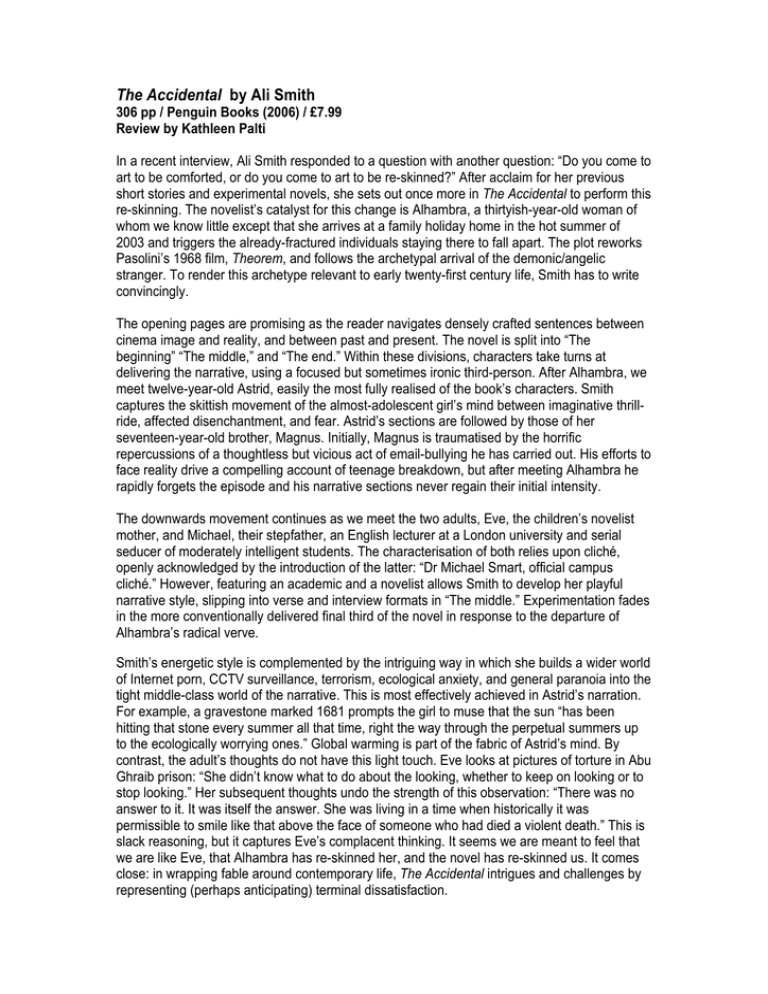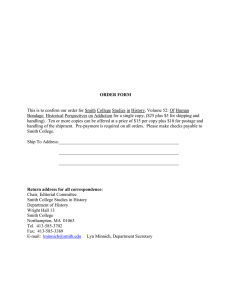The Accidental
advertisement

The Accidental by Ali Smith 306 pp / Penguin Books (2006) / £7.99 Review by Kathleen Palti In a recent interview, Ali Smith responded to a question with another question: “Do you come to art to be comforted, or do you come to art to be re-skinned?” After acclaim for her previous short stories and experimental novels, she sets out once more in The Accidental to perform this re-skinning. The novelist’s catalyst for this change is Alhambra, a thirtyish-year-old woman of whom we know little except that she arrives at a family holiday home in the hot summer of 2003 and triggers the already-fractured individuals staying there to fall apart. The plot reworks Pasolini’s 1968 film, Theorem, and follows the archetypal arrival of the demonic/angelic stranger. To render this archetype relevant to early twenty-first century life, Smith has to write convincingly. The opening pages are promising as the reader navigates densely crafted sentences between cinema image and reality, and between past and present. The novel is split into “The beginning” “The middle,” and “The end.” Within these divisions, characters take turns at delivering the narrative, using a focused but sometimes ironic third-person. After Alhambra, we meet twelve-year-old Astrid, easily the most fully realised of the book’s characters. Smith captures the skittish movement of the almost-adolescent girl’s mind between imaginative thrillride, affected disenchantment, and fear. Astrid’s sections are followed by those of her seventeen-year-old brother, Magnus. Initially, Magnus is traumatised by the horrific repercussions of a thoughtless but vicious act of email-bullying he has carried out. His efforts to face reality drive a compelling account of teenage breakdown, but after meeting Alhambra he rapidly forgets the episode and his narrative sections never regain their initial intensity. The downwards movement continues as we meet the two adults, Eve, the children’s novelist mother, and Michael, their stepfather, an English lecturer at a London university and serial seducer of moderately intelligent students. The characterisation of both relies upon cliché, openly acknowledged by the introduction of the latter: “Dr Michael Smart, official campus cliché.” However, featuring an academic and a novelist allows Smith to develop her playful narrative style, slipping into verse and interview formats in “The middle.” Experimentation fades in the more conventionally delivered final third of the novel in response to the departure of Alhambra’s radical verve. Smith’s energetic style is complemented by the intriguing way in which she builds a wider world of Internet porn, CCTV surveillance, terrorism, ecological anxiety, and general paranoia into the tight middle-class world of the narrative. This is most effectively achieved in Astrid’s narration. For example, a gravestone marked 1681 prompts the girl to muse that the sun “has been hitting that stone every summer all that time, right the way through the perpetual summers up to the ecologically worrying ones.” Global warming is part of the fabric of Astrid’s mind. By contrast, the adult’s thoughts do not have this light touch. Eve looks at pictures of torture in Abu Ghraib prison: “She didn’t know what to do about the looking, whether to keep on looking or to stop looking.” Her subsequent thoughts undo the strength of this observation: “There was no answer to it. It was itself the answer. She was living in a time when historically it was permissible to smile like that above the face of someone who had died a violent death.” This is slack reasoning, but it captures Eve’s complacent thinking. It seems we are meant to feel that we are like Eve, that Alhambra has re-skinned her, and the novel has re-skinned us. It comes close: in wrapping fable around contemporary life, The Accidental intrigues and challenges by representing (perhaps anticipating) terminal dissatisfaction.




